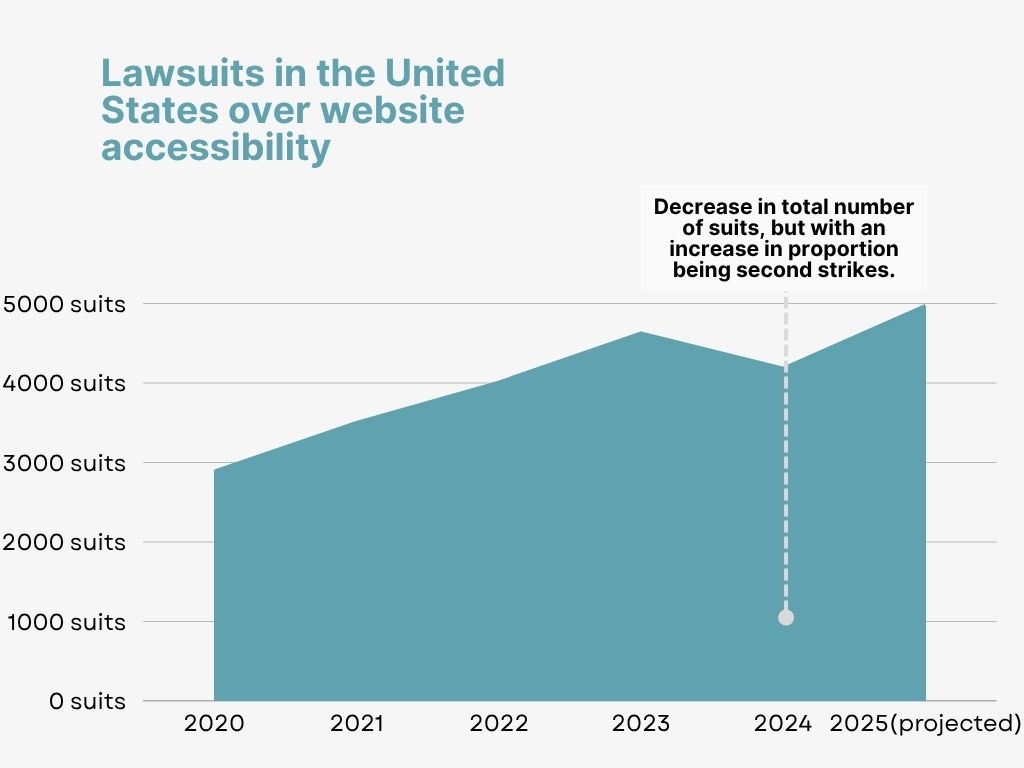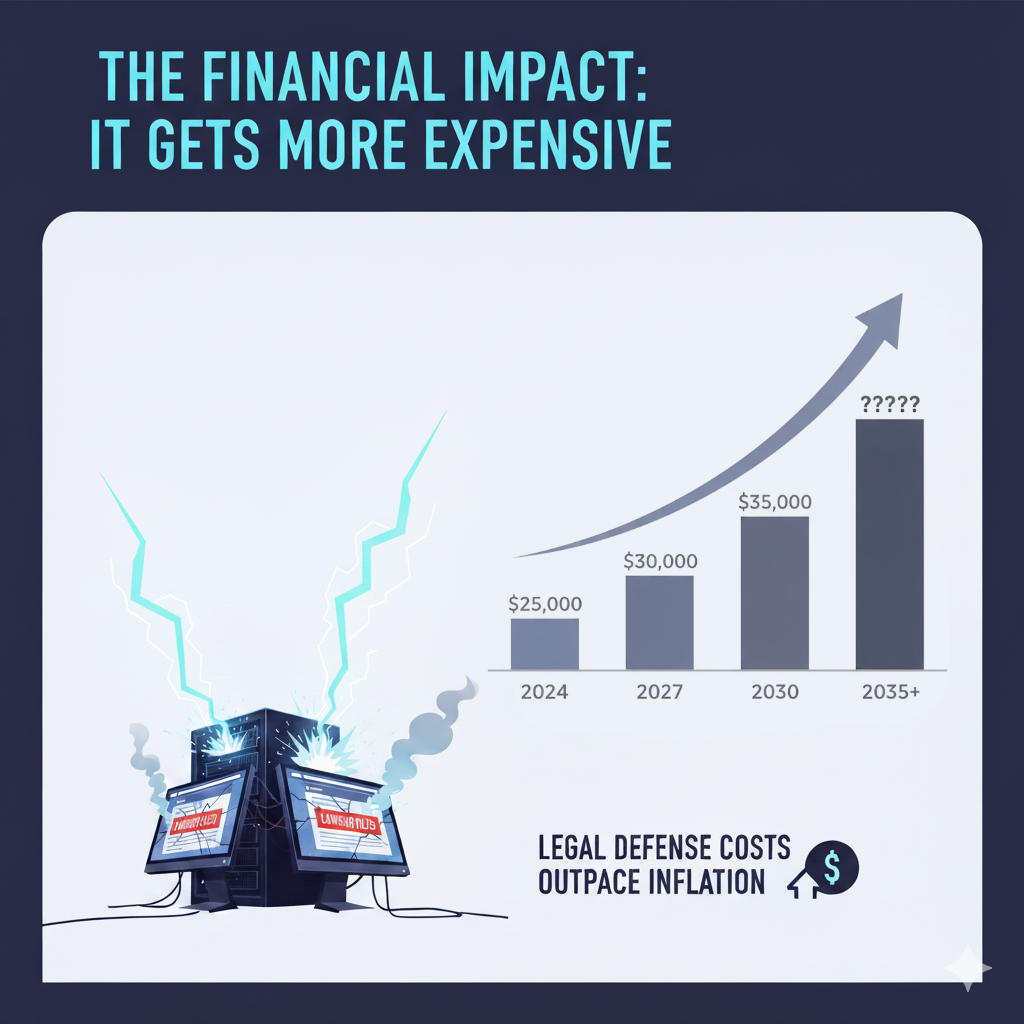The lightning strike of an accessibility lawsuit can feel like a once-in-a-lifetime event, though unfortunately that's not the case. You should take some important steps to make sure you don't get hit with a lawsuit again.
There's an old wives' tale that lightning never strikes the same place twice. It's a comforting notion that suggests we're somehow protected from experiencing the same misfortune more than once. Former Shenandoah National Park ranger Roy Sullivan could tell you that the idea is simply not true, though, since he was struck by lightning seven times throughout his life!
If you've already faced a web accessibility lawsuit, you might be hoping that your own version of this old wives' tale holds true: that having been sued once somehow immunizes you from future legal action. Unfortunately, when it comes to digital accessibility litigation, your company is more like Roy Sullivan than you might think. Not only can lightning strike twice in the world of ADA website compliance lawsuits, but your odds of being struck again actually increase after that first lawsuit, particularly if you haven't taken comprehensive steps to address the underlying accessibility barriers on your website.
According to data from Usablenet, a company that tracks lawsuits having to do with website accessibility every year, lawsuits have continued to increase over the past five years, with a notable exception of a slight decrease in 2024. That year, however, there was a small but significant increase in the proportion of defendents who had had a previous ADA digital lawsuit. Perhaps the industry was just retooling to ramp up their repeat-suit business. And this year we're on track to have nearly a 20% increase in lawsuits over last.

That increase in repeat defendants is notable. The reality is sobering: companies that have faced accessibility litigation once become lightning rods for repeat lawsuits. Whether it's because plaintiffs' attorneys maintain lists of previous defendants, because your website remains discoverable through accessibility scanning tools, or simply because you've demonstrated that accessibility isn't a priority for your organization, that first lawsuit can mark you as an easier target for the next one. And the next. And potentially the one after that.
So regardless of why this happens, what can you do to break the cycle? Understanding the dynamics of repeat accessibility litigation—and taking decisive action to address the root causes—is essential for any organization that's already been through this painful experience once and wants to ensure it never happens again.
The Numbers Don't Lie: You're Now in a Higher-Risk Category
General Lawsuit Risk
Repeat Lawsuit Risk (For Previous Defendants)
*Numbers are estimates for illustrative purposes. Click numbers for sources.
Let's put the numbers into perspective. With projections suggesting nearly 5,000 web accessibility lawsuits will be filed in 2025, around 2,000 of those will target companies that have already been sued at least once. 5000 out of an estimated 2.7 million ecommerce stores means the statistical likelihood of being sued over accessibility concerns is less than .2%.
Although this is still exponentially greater than your risk of being struck by physical lightning, here's where it gets scary. If you've been sued for accessibility violations before, now you're in a different category: now you're in the exclusive club of about Think about what that means: if you've already faced an accessibility lawsuit, you're now part of a statistical pool where your likelihood of being sued again has dramatically increased.
Now you're in the pool of roughly 25,000 companies that have already been sued, about 2000 of which are likely to have been sued again this year. In that light, your liklihood for suit has increased to about 16%. Yep, the data suggests that once you've been sued, the litigious lightning is statistically more likely to strike you a second time than it was to strike you the first time.
This isn't just bad luck or random chance. These numbers reflect a systematic pattern in how accessibility litigation unfolds. Previous defendants have, in essence, already raised their hand and identified themselves as organizations with accessibility problems. And plaintiffs' attorneys are paying attention.
The Financial Impact: It Gets More Expensive the Second Time Around

Beyond the increased likelihood of facing repeat litigation, there's another harsh reality to consider: the financial toll of a second lawsuit is likely to be even steeper than the first. According to Kris Rivenburgh, an attorney who specializes in defending web accessibility lawsuits and writes extensively on ADA compliance, a conservative estimate for the total cost of defending a website accessibility lawsuit was $25,000 back in 2024. That figure accounts for attorney's fees, potential settlement costs, and related expenses, and it represents a baseline, not a worst-case scenario.
But here's the kicker: if you're facing your second (or third) accessibility lawsuit, you shouldn't expect to pay 2024 prices. Legal defense costs across all types of class action litigation have been rising significantly. A recent survey analysis by Frost Brown Todd, a national law firm that tracks litigation trends and defense costs, revealed that defense spending and the expected costs of class action lawsuits have substantially outpaced inflation. For companies dealing with repeat litigation, this means each subsequent lawsuit is likely to cost more than the last, not just because of general inflation, but because of the specific dynamics of defending accessibility claims when you have a documented history of non-compliance.
Think about what this means for your bottom line. If your first lawsuit cost you $25,000 in 2024, and you haven't meaningfully addressed the accessibility issues on your website, a lawsuit a few years later could easily cost you $30,000 or more as defense costs continue their upward trajectory. And if you find yourself facing yet another lawsuit down the road? The costs continue to compound. At that point, you're not just paying legal fees; you're hemorrhaging resources that could have been invested in actually fixing the problem in the first place.
Breaking the Cycle: It Doesn't Have to Be Inevitable
Here's the good news: unlike Roy Sullivan and his lightning strikes, you have far more control over whether accessibility litigation strikes you again. A second lawsuit isn't inevitable, but avoiding it requires more than just settling the first case and hoping for the best. The key lies in implementing a high-level, comprehensive approach to accessibility that transforms your website from a liability into a genuinely inclusive digital experience.
Level 1: Remediation Alone = Potentially Decreased Risk
Simply remediating the accessibility issues identified in your first lawsuit is a start, and it may reduce your risk somewhat. You'll have fixed the specific problems that were called out, after all.
But here's the catch: if you don't understand why those issues existed in the first place or how to prevent new ones from being introduced, you're essentially playing whack-a-mole with accessibility barriers. New content gets added, features get updated, and before long, new violations pop up.
Level 2: Remediation + Training = Definitely Decreased Risk
When you combine remediation with comprehensive accessibility training for your content creators, developers, and designers, you're moving from reactive to proactive. Your team now understands accessibility principles and can make better decisions as they build and maintain your site.
This significantly reduces your risk because you're not just fixing yesterday's problems, you're preventing tomorrow's. However, even well-trained teams can slip into old habits without structure and accountability.
Level 3: Remediation + Training + Established Procedures = Far Lower Risk
This is where you start to see dramatic risk reduction. By establishing formal procedures for how content should be added and reviewed for accessibility, you're building accessibility into your workflow rather than treating it as an afterthought. Everyone on your team knows the steps to follow, and there are checkpoints before content goes live, so accessibility becomes part of your standard operating procedure rather than something you remember to check occasionally.
At this level, you've made it much harder for accessibility issues to slip through the cracks.
Level 4: Remediation + Training + Procedures + Ongoing Monitoring + = Practically Lightningproof
This is the gold standard, and it's what separates organizations that face repeat litigation from those that truly solve the problem. Ongoing accessibility monitoring means you're continuously scanning your website for issues, catching problems before they accumulate, and maintaining compliance even as your site evolves. As we've discussed in our post on accessibility monitoring, automated tools can flag potential issues in real-time, while periodic manual audits ensure that you’re also addressing the nuanced aspects of accessibility that machines can't fully evaluate.
When you reach this level, you've created a sustainable accessibility program that doesn't rely on any single person or moment in time. At this point, plaintiffs' attorneys looking for easy targets will likely move on to organizations that haven't taken accessibility seriously—because you clearly have.
Reactive Fixes
You're fixing the problems that were called out, but new ones can still appear.
Proactive Foundation
Your team starts preventing tomorrow's problems, not just fixing yesterday's.
Integrated Workflow
Accessibility becomes a standard part of your process, not an afterthought.
Sustainable Program
You've created a resilient, long-term system that maintains compliance as your site evolves.
Dodging the strike
While your statistical likelihood of being sued again does increase after the first suit, that second strike isn't inevitable by any means. If you do the things we suggest here, hopefully you can avoid the fate of Roy Sullivan, and remain a single-strike victim rather than continue to be a lightning rod.

